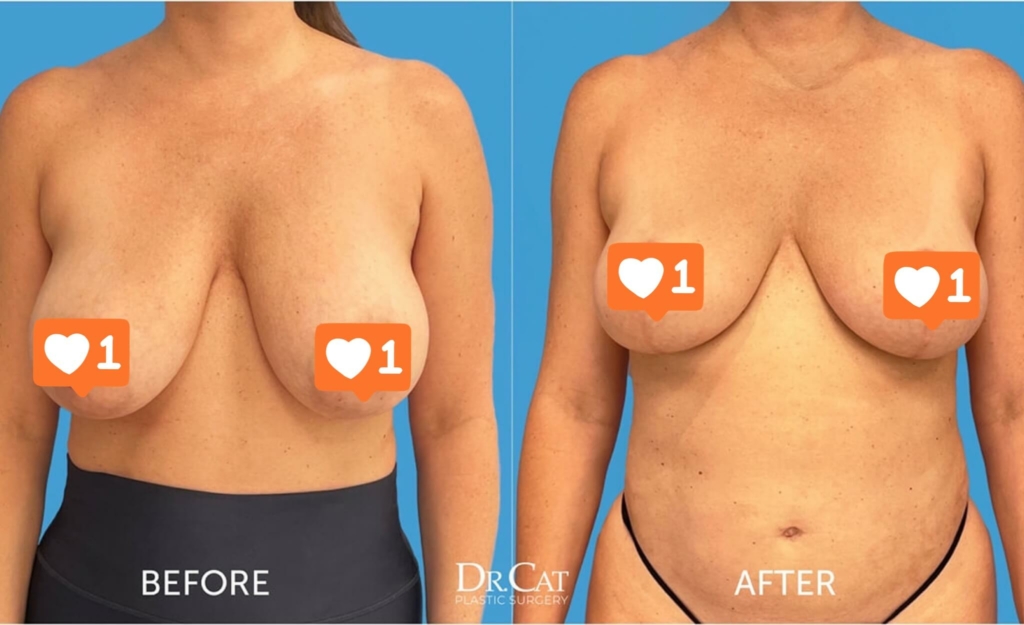Navigating Breast Reduction for Dense Breasts: What You Should Know
Voluptuous cleavage might seem desirable to some, but for many women, the reality isn’t so sexy. Back pain, shoulder strain, embarrassment, shame—the weight of large, cumbersome breasts is more than physical.
If you’re tired of carrying the heavy burden of dense breasts, breast reduction offers a promising path toward restoring your sense of self. Just imagine: no more struggling to find clothes that fit, no more insecurity, discomfort.
At Dr. Cat Plastic Surgery, we’re no strangers to the struggles women with dense, oversized breasts face in their daily lives. After thousands of breast surgeries, we’re proud to be the glimmer of hope for those who once saw no solution.
In this article, we explore the nuances of dense, heavy breasts, as well as the life-changing benefits of breast reduction surgery.
If you’re ready to fall back in love with your décolletage, keep reading.
What is Dense Breast Tissue?

Breast density refers to the composition of certain breast tissue, in which there’s a higher proportion of glandular and connective tissues than fatty tissues. In simpler terms, dense breasts have more firm, heavy tissue than the softer, fatty kind.
When it comes to breast density, there are four distinct categories:
- Heterogeneously dense breasts (mostly glandular and fibrous connective tissue)
- Extremely dense breasts (mostly fibrous with very little fat)
- Scattered fibroglandular breasts (made up of both dense glandular and fibrous tissue)
- Almost entirely fatty breasts (made mostly of fatty tissue)
How do you know if you have dense breasts? You might think you can just squeeze your breasts and see how firm they are, but it’s not that simple.
Signs and Causes of Excess Breast Density
The most accurate way to detect breast density is through mammograms. This x-ray shows breast tissue composition, with dense areas appearing more solid.
Other signs that you may have excessive breast density are:
- Physical discomfort (like neck, shoulder, and back pain)
- Posture problems from carrying excess weight
- Difficulty working out and other physical activities
- Issues with finding well-fitting clothes and bras
- Self-consciousness and unwanted attention
- Skin irritation (like bra strap indentations or chafing)
As for why breast density occurs, there could be several factors at play such as genetics, weight, or hormonal fluctuations.
But addressing breast density isn’t just about improving your quality of life; it could be a life-saving health consideration. Dense breasts are also one of the most common risk factors for breast cancer.
The kicker? Dense breasts make mammograms really tricky to read. Since breast density shows up as solid white areas, it makes it harder to see masses or other abnormalities (which also show up as white patches) on breast health screenings.
The good news is that dense breast tissue surgery makes cancer detection easier and leads to a more fulfilling life.
Breast Reduction for Dense Breasts
Breast reduction surgery, also known as a reduction mammoplasty, is a cosmetic procedure to reduce the size of your breasts. It also raises the breasts, along with your nipple and areola, to a more natural, aesthetic position.
This removal of excess breast tissue translates to a decrease in breast density, as it leaves less glandular and fibrous tissue in your breasts.



Thinking about taking this step? Let’s go over the pre-op process.
Preparing for Breast Reduction
Your breast reduction for dense breasts starts with a thorough consultation with Dr. Cat. At this appointment, she’ll review your case, anatomy, medical history, and aesthetic goals, allowing her to tailor a surgical plan just for you.
If you’re thinking of undergoing a reduction for dense breasts, procedure considerations you’ll want to keep in mind include:
- Your surgeon’s approach
Breast reduction techniques for dense tissue vary from case to case. Surgeons like Dr. Cat customize their approach based on your anatomy and desired look. Talk to your provider about suitable techniques and the potential outcomes of each.
- Potential risks
Surgery for dense breasts carries surgical risks such as:
- Asymmetry
- Visible scarring
- Infection
- Anesthesia reactions
- Blood clots
- Need for revision surgery
One way to prevent these complications? Do your homework and choose a renowned surgeon with decades of experience and a portfolio of happy, healthy patients.
- Your ideal size and shape
At your consultation, you’ll examine ideal breast sizes for your height and weight. If you combine your reduction with implants, Dr. Cat will let you examine different samples and help you find a size that suits you best.
- Financial investment and insurance coverage
According to CareCredit (a plastic surgery financing option), the average breast reduction cost in the U.S. ranges between $2,768 and $19,000. In cases where your procedure is medically necessary, your insurance might cover some of the costs.
Now, let’s take a peek at what your surgery entails.
Reducing Density with Breast Reduction
Dr. Cat performs your breast reduction under general and local anesthesia to ensure a peaceful, pain-free experience.
She first removes fat and excess tissue from your breasts, making them smaller and lighter. She then artfully reshapes each breast, meticulously contouring the skin pocket around it.
Once she achieves a comfortable and proportionate size, she performs a breast lift to elevate the breasts and nipples to a more natural position. Dr. Cat does this through carefully placed incisions around your areola, into the nipple, and down to the breast crease.
As a specialist in minimal scar breast surgeries, Dr. Cat closes each incision, leaving little trace of any procedure.
Recovery from Breast Reduction
Does breast reduction recovery look different for patients addressing density? Not at all!
Immediately post-op, you’ll experience some swelling and tenderness around the surgical site.
You’ll also emerge wearing a post-surgical support bra, as well as drains to keep fluid accumulation out of the space left by the removed tissue. But don’t worry—your drains will be out in a week. However, you’ll wear your surgical bra for at least two months.
In the next two to three weeks, your main focus is healing after breast surgery. As the weeks pass, you’ll gradually return to your daily routine. Dr. Cat will clear you for certain activities (like arm movements and exercise) at different phases.
After four to six months, you’re fully healed and embracing an era of lighter, more proportionate breasts!
…but that’s not the only perk.
Results and Benefits of Breast Reduction
The physical and emotional impact breast reduction has on patients’ lives is truly priceless.
Some of the most notable benefits include:
- Less pain and discomfort
- Better posture and mobility
- Improved physical activity
- Clothing fits better
- Less skin irritation
- Relief from bra strap grooves
- Increased self-esteem
- Clearer mammograms
- Reduced breast sagging
- Better sleep quality
Most importantly, you’ll feel as unstoppable as you look.
Dr. Cat Plastic Surgery: From Dense to Dazzling
It’s time to stop limiting yourself because of uncomfortably dense breasts. Breast reduction is your key to making it happen. This procedure can empower you to live a life where your comfort, confidence, and health are in perfect harmony.
Let’s turn the page on a chest no longer holds you back.
Schedule a breast reduction consultation with Dr. Cat today.

